













There’s
Common Plumbing Emergencies:
• No hot water
• Overflowing sink
• Overflowing toilet
• Clogged drain
• Frozen pipes
• Burst pipes





















There’s
Common Plumbing Emergencies:
• No hot water
• Overflowing sink
• Overflowing toilet
• Clogged drain
• Frozen pipes
• Burst pipes






PUBLISHING
David Nivens, Publisher david@comocompanies.com
Chris Harrison, Associate Publisher chris@comocompanies.com
EDITORIAL
Jodie Jackson Jr, Editor jodie@comocompanies.com
Kelsey Winkeljohn, Associate Editor kelsey@comocompanies.com
DESIGN
Jordan Watts, Senior Designer jordan@comocompanies.com
Lacy Tiegs, Marketing & Website Associate lacy@comocompanies.com
MARKETING
Charles Bruce, Director of Client Relations charles@comocompanies.com
Kerrie Bloss, Account Executive kerrie@comocompanies.com
CONTRIBUTING PHOTOGRAPHERS
Keith Borgmeyer, Jessica Park, Trischa Splitter/Junebug Photography, Hoss Koetting
CONTRIBUTING WRITERS
Sunitha Bosecker, Beth Bramstedt, Barbara Bu aloe, Caroline Dohack, Jodie Jackson Jr, Hoss Koetting, Ryan Sheehan
COMO ADVISORY BOARD MEMBERS
Beth Bramstedt, Heather Brown, Nickie Davis, Sam Fleury, Chris Horn, Jeremiah Hunter, Kris Husted, Amanda Jacobs, Megan Steen, Nathan Todd, Wende Wagner
SUBSCRIPTIONS
Magazines are $5.95 an issue. Subscription rate is $54 for 12 issues for one year or $89 for 24 issues for two years. Subscribe at comomag.com or by phone. COMO Magazine is published monthly by e COMO Companies.
OUR MISSION STATEMENT
COMO Magazine and comomag.com strive to inspire, educate, and entertain the citizens of Columbia with quality, relevant content that re ects Columbia’s business environment, lifestyle, and community spirit.
Copyright e COMO Companies, 2024 All rights reserved. Reproduction or use of any editorial or graphic content without the express written permission of the publisher is prohibited.
or a
inquiry? Email
In my 23.9 years of living,
I’ve been incredibly fortunate when it comes to my physical health. I’ve seen friends go through some serious medical hurdles — appendix removals, broken bones, stitches, surgeries, and even kidney stones.
But me? None of that, thankfully (knock on wood). Am I maybe a little too cozy with my bag of chips and the couch? Sure. But that’s between me, my snacks, and Hulu to gure out.
Mental health, though, has been a different story, and I’ve dealt with anxiety for as long as I can remember. My earliest memory goes back to rst grade: my mom would drop me o at school, and the moment she left, I’d feel this wave of panic. Back then, I didn’t fully understand what I was feeling, but I knew it was overwhelming.
Now, as an adult, anxiety is still very much a part of my life. e triggers have changed, but the feeling remains the same. e good news is that over the years, I’ve learned ways to manage it, and I’d like to share just a few with you.
One activity that joined my “hobby roster” during the early days of COVID was puzzles. While it might seem a bit old-fashioned, puzzles o er numerous mental health bene ts: they help shift focus away from anxious thoughts, build cognitive resilience to navigate stressful situations, and reduce screen time. e repetitive process of tting pieces together or solving patterns can also have a meditative, calming e ect on the brain.
Another way I keep my mental health in check is by going outdoors. I’ll admit there are days when it’s hard to get up and face the world, but having a dog has made a huge di erence in my routine — and my mindset. I’m not saying that everyone and their mother should go out and adopt
a pet right now, but having a dog means I have to get outside, even when I don’t feel like it.
Most days, I leave my phone inside and just listen to the world around me as I walk — the birds, the hum of cars going by, the laughter of kids walking to their bus stop. e combination of fresh air, sunlight, and a moment to pause often helps people feel connected to the world around them. Sometimes, taking a photo of a scenic view can act as a small yet meaningful reminder of the beauty present in our everyday moments, even when they feel routine and mundane.

This collage combines text and images from Stephens Life (SL) and the Columbia College Literary Review to evoke feelings of nostalgia and liminal space. Coincidentally, it features COMO freelance writer Lydia Graves’ story title, “Shh... Minimalism is Sleeping” from the spring 2022 issue of SL.
My most recent pursuit is collaging. ere’s something so calming about cutting up old magazines or scraps of paper and piecing them together with your keepsakes. It forces you to focus on the present moment, choosing colors, textures, and images that speak to you. ere’s no right or wrong way to do it, and when you’re done, you’re left with a reminder of your ability to create beauty out of chaos. ese activities don’t cure anxiety, but they can help manage it. And in my experience, even small steps can make a world of di erence.
Now, without further delay, I present to you our 2025 Health & Wellness issue. Happy reading!


KELSEY WINKELJOHN ASSOCIATE EDITOR kelsey@comocompanies.com
Barred Owl’s “Par for the Course” mocktail—a bold and refreshing option for those choosing a sober sip.
Photo by Keith Borgmeyer










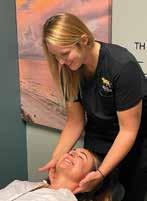
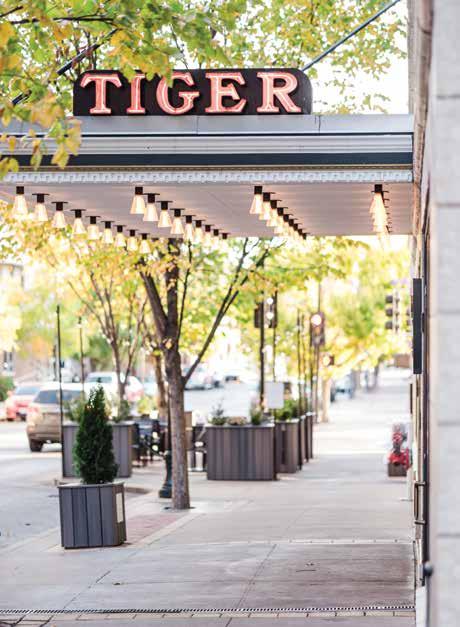

Boone Hospital’s Healing Garden and labyrinth offer holistic paths to wellness.
BY COMO STAFF | PHOTOS BY JESSICA PARK/BOONE HEALTH


Alabyrinth is about clarity and peace of mind — not confusion. at’s why we shouldn’t use the terms “labyrinth” and “maze” interchangeably. And it’s the focus on spiritual wholeness and healing of the mind, body, and spirit that is at the heart of the Boone Health labyrinth, located at the southeast corner of the intersection of Williams and Walnut streets.
Boone Health’s website and the Fall 2024 issue of My Boone Health magazine highlight those healing and peace of mind characteristics.
Labyrinths can be found in almost every religion and every culture. ey are an ancient work of art, a spiritual tool to bring together a community of people of many faiths and traditions.
• Pause at the entrance, open the heart and clear the mind. Be aware that you are entering a sacred symbol, a sacred path.
• You may wish to say a prayer, ask a speci c question or choose a particular intention for walking (such as physical healing, inner peace, regaining balance, etc).
• Begin walking slowly, following the winding path towards the center. Walk at your own pace. e path is two ways; those going in will meet those coming out. If you meet another on the path going or coming, simply step aside and pass with reverence—this is easiest at the turns.
• In the center, pause and stay as long as you like. Let it be a time of meditation and prayer. Receive what is there for you to receive. en exit by the same path you entered.
Boone Health’s goal is to maintain the labyrinth as a healing resource for the patients and sta of Boone Hospital Center and for the mid-Missouri community.


e Barbara A. Weaver Healing Garden at Boone Hospital o ers a tranquil place for patients, visitors, and employees. e 12,380-square-foot garden area features trees, owers, waterfalls, and soothing music. e Healing Garden opened in 2012 with support from donors to the Boone Hospital Foundation, and many of the paving bricks in the garden display the names of donors as well as medical sta , employees, and patient families.
e Foundation designed the garden based on research that con rmed how
healing gardens can help ease patient stress, foster a supportive environment between patients and friends or family members, encourage exercise, and provide a distraction from loud noises, bright lights and the lack of privacy often associated with hospital stays.
e garden is designed to appeal to all senses. In addition to the sights, smells and textures of the ora, there is the sound of waterfalls and soft music piped in. e garden also is easily accessible from the patient towers. Walks and
footbridges are wide enough for wheelchairs, and there are plenty of places to stop and rest.
e Healing Garden was dedicated in Barbara Weaver’s name in 2016. Weaver became the rst woman elected to the Boone Board of Trustees in 1981, and she served in that capacity until 2015.
e garden addition came 92 years after construction crews broke ground on Boone County Hospital on May 30, 1920.
e grand opening followed on December 10, 1921.




3, 2, 1 …
Columbia’s gifted student center has its own Moon Tree.
BY BRANDON KNIGHT
The year is 1971 when NASA astronaut Stuart Roosa takes tree seeds on Apollo 14. It would be NASA’s third trip to the moon, and the seeds took a ride aboard NASA’s Orion spacecraft.
On board the Orion some fty-four years ago, Roosa hauled an estimated 1,000 tree seeds. e variants included loblolly pine, sweet gum, redwood, Douglas r, and sycamore tree seeds. During the next four to six weeks, and after thousands of miles and thirty-four complete lunar orbits, the seeds came back to Earth. Once home, the U.S. Department of Agriculture Forest Services turned the seeds into seedlings.
e seedlings produced trees that in 2022 had seeds of their own, and some took ight back to the Moon on Artemis I. at voyage included seeds for Loblolly pine, American sycamore, sweetgum, Douglas r, and giant sequoia, all packed into ravioli-like packages. e seeds spent four weeks in space before returning to Earth.
e NASA O ce of Engagement and NASA’s Artifact Module has invited schools, universities, and federal agencies to be stewards of the seeds. Seed distributions occurred in the spring and fall of 2024, with others coming up in the spring and fall of 2025. Two of the seeds made it to Missouri — one in Lee’s Summit and the other in Columbia. Columbia received seed number 119, an American Sweetgum.
Representatives from the NASA O ce of STEM Engagement came to the EEE Center on October 18, 2024, for a dedication ceremony to o cially recognize the center’s Moon tree.
“It’s a big deal that NASA chose us. [We have] high interest in space and science; the kids are really excited about it,” said Elizabeth Brown, the CPS Extended Education Experiences (EEE) gifted program teacher. Brown submitted the application for an Artemis tree seed.
With the help of Samuel Wright, a certi ed arborist, the seed was planted and sprouted at the Eugene Field Center, home to Columbia’s EEE program. e EEE program takes gifted students from twenty-one schools across the Columbia Public Schools system, as well as some private and homeschooled students who meet certain criteria. e gifted students are given a challenging, accelerated program to help foster their growth within the Columbia education system.
Every March, CPS kindergarten and second-grade students take the Naglieri Nonverbal Ability Test (NNAT3). e NNAT3 measures students’ problem-solving skills and measures their aptitude. Students within the 80 percent percentile or higher are eligible for further assessment. With permission from parents or guardians, the students may then take a cognitive exam for further evaluation. Gifted services are o ered to students who meet Mis-
souri state guidelines of the top 3 percentile. If a student meets those criteria, they are eligible for Columbia’s EEE program. Currently, 600 gifted students are educated each year through the EEE program.
Gifted students in Columbia attend the program in trimesters, ranging from ten to twelve weeks. Students attend the EEE one day a week and start their day in their “homeroom” for about an hour. en students go to their major course, which will take place three times a year.
Kristen Palmer, director of Elementary Gifted Services, said the EEE program has nine teachers who write their own curriculum and create the courses. Students get the chance to vote on their favorite pick. Some past and present major courses are Legos Sparo Edition, Traveling rough Dimensions, Chasing Vermeer, Latin, Puppetry, Wolves North American, and African Animals.
“We try to cover a little bit of everything so they can focus on what they like, or try di erent things,” said Palmer. e program gives gifted students a way to excel within the public school system. However, Brown said, there are still myths surrounding gifted students — such as gifted students are elitist or do not need academic help, or that if they have poor grades, they cannot be gifted.
“ ere is a misconception that gifted kids are always great at school, and I think that puts a lot of pressure on them,” she added.
Many of the students are one to two years ahead of their peers, and their average IQ score is 130, which is the top 2 percent of individuals.
“ ese are those kids that think outside of that normal range,” said Palmer. With that comes di culties in the regular classroom, especially since the students are not immune to being neurodivergent.
Brown explained, “Some students whose brains are working overtime, they’re 6 years old, and their IQ is 137, and they don’t quite know how to navigate in the world.”
Regular curriculum could bene t from gifted curriculum as well.
“ e problem is regular teachers have so much on their plates,” Brown said. “ is sta is really good at helping to be a resource for regular education teachers. With any luck, one day a Columbia Public School student enters space for the rst time aboard a NASA ight. Something we need to remember is, ‘At the end of the day they are kids.’”
What’s next for space ight? In mid-2026, Artemis II is set to launch for a lunar orbit, a ten-day mission around the Moon to prepare for the next mission. In 2027, the Artemis III crew will feature the rst woman and a person of color to walk on the Moon.
BY M C KENNA STUMPH
DeafLEAD is a Deaf-run and Deaf-led nonpro t organization o ering 24/7 crisis intervention, advocacy, case management, interpreting, and mental health support services to victims of crime who are Deaf, Hard of Hearing, DeafBlind, and Late-Deafened individuals and their families. e name of the organization is an acronym for Leadership through Education and Advocacy for the Deaf. It was derived to express that the organization is a culmination of Deaf people leading. Dr. Stephanie Logan, CEO at DeafLEAD, was the organization’s rst employee twenty-nine years ago.
“ e focus and mission of the organization are to provide victim services. In my earliest time with the organization, I always wanted to provide a crisis line for the Deaf community in particular,” Dr. Logan signed.
Dr. Logan is responsible for bringing the crisis line to mid-Missouri after doing research about the needs of the Deaf community and connecting with DeafLine Chicago for input on establishing a crisis line. As a result, a similar crisis line was established in Missouri, called DeafLine Missouri. Established more than twenty- ve years ago, the crisis line was run mainly by volunteers, with only a few sta members.
Shortly after DeafLine Missouri was established, Dr. Logan said it became clear that services for a hearing crisis line were also needed, and that led to creating the Mid-Missouri Crisis Line. at service helped DeafLine Missouri recruit more volunteers, and those volunteers helped run the crisis line. at’s how DeafLine ran for several years until July 1, 2024.
With the 988 crisis line established two years ago, the Mid-Missouri Crisis Line was no longer needed. e 988 Suicide and Crisis Lifeline is available 24/7 for call, chat, text, or videophone for people who are in crisis or needing emotional support or resources. Once the Mid-Missouri Crisis Line was disbanded, DeafLEAD transi-
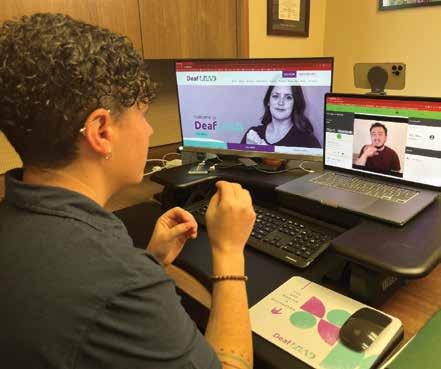
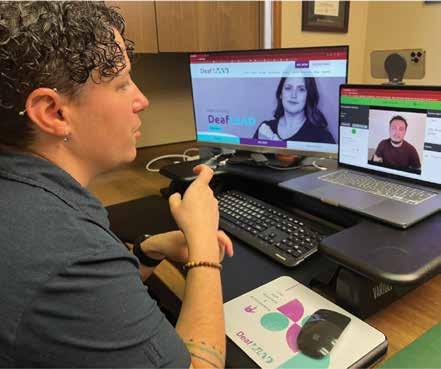
1994
Youth L.E.A.D. Foundation was formed.
1995
Dr. Logan became the CEO of Youth L.E.A.D. Foundation and changed the name to DeafLEAD.
1996 DeafLEAD Victim Services began.
1997
Deafline Missouri (TTY) and Missouri Crisis Line (MCL) established for victims of crime.
2012 Missouri Crisis Text Line was established.
2017
Deaf Crisis Line Videophone was established.
Disaster Distress Helpline (DDH) and National Suicide Prevention Lifeline (NSPL – now known as 988) contracted with DeafLEAD for TTY Services.
2018
DeafLEAD becomes the first “for Deaf, by Deaf” organization to receive accreditation through the American Associate of Suicidology.
2020
The Disaster Distress Helpline contracts with DeafLEAD to establish the first national disaster-related videophone hotline; DDH-VP.
DeafLEAD is selected as a National Chat and Text Center for the National Suicide Prevention Lifeline.
2022
DeafLEAD is selected as a National Chat and Text backup center for the NSPL transitioning to 988.
988 Launched and DeafLEAD became the statewide provider of Missouri 988 Chat and Text Services.
tioned to a fully paid sta model with more than 400 employees. Previously, DeafLEAD was supported by about fteen employees and a small army of volunteers.
“I started as a volunteer in 2016 and that was how we were able to function,” said Tyler Hannsz, director of crisis chat services for DeafLEAD. “Our volunteers were the bread and butter. It has changed pretty radically since then.”
e chat and text program at DeafLEAD, directed by Hannsz, serves as a national backup center to the 988 Lifeline. It is one of many 988 chat and text centers across the country — and the sole designated 988 chat and text center for Missouri.
In October, the center responded to 15,000 contacts; the total for the past twelve months is 133,000 contacts. When it was started in 2020, the center received a thousand contacts. e service provided is less specialized than videophone, requiring only the individual to enter their zip code to be routed to the nearest center, which sometimes includes individuals not in the state of Missouri.
“Often people will perceive [Deaf individuals] as less educated, less knowledgeable — especially when it comes to our English abilities and language abilities,” signed Olivia Stein, director of videophone crisis line services. “On the chat and text line, we do have Deaf individuals who work that line and answer chat and text in English. Whenever some people learn that, we get a quizzical look, like, ‘Can they handle that? Can they communicate well?’” at level of doubt also adds to the stigma about a Deaf individual’s abilities, she signed.
“It forces us to educate whoever we’re working with,” she signed. “ ere’s also ongoing education of terminology. ‘Hearing impaired’ is considered an insult to those of us in the community.”
Stein reported that there are two lines in use. e 988 Videophone (VP), which has been in operation for a year, has had over 37,000 calls. e average monthly volume ranges from 1,200 to 6,000 calls. For the nationwide Deaf Crisis Line, which is a smaller program, the call volume has hit 35,000 in the last seven years. at line averages just over 300 calls each month.
In a typical phone call or traditional crisis call, the Video Relay Service (VRS) involves a third party to facilitate a three-way conversation between an interpreter, a Deaf individual, and a hearing individual. is allows individuals of the Deaf community to communicate in their native language, American Sign Language (ASL), which is then interpreted for the hearing individual. In contrast, the VP crisis line is a two-way conversation between a crisis counselor and a Deaf community member or ASL user, where both participants communicate directly in ASL, without the need for an interpreter.
“What’s unique about our organization is that we are a Deaf-run organization. Many, if not most organizations, that provide Deaf services, are run by hearing individuals and intended for the Deaf community,” Dr. Logan signed. at means there are Deaf individuals making decisions about community needs, “based on the lived experience we have,” she added. “It is such an important piece to us that we are Deaf-run and Deaf-led. It’s cool to see Deaf and hearing individuals collaborating and working together.”
DeafLEAD
Address: 2505 West Ash
Voice Phone: (573)445-5005
Video Phone: (573)303-5604
Text: Text HAND to 839863
Website: deaflead.org

The ‘Tiger’ experience provides elegance, barbecue, and signature brunch.
BY SUNITHA BOSECKER
PHOTOS BY TRISCHA SPLITTER/ JUNEBUG PHOTOGRAPHY
The iconic Tiger Hotel, with its rooftop marquee lighting up the Columbia skyline, has become a beacon of both history and hospitality in Missouri. Dating to 1928, e Tiger Hotel was considered a lavish option for travelers and locals. e storied hotel has dominated the skyline since its 2014 renovation, blending the best of modern comfort with a deep sense of local history.
As you step through its doors, the lobby’s stately open design — complete with grand staircases and an open front desk — welcomes you into a space that feels both digni ed and approachable.
Checking in is a breeze, thanks to the a able sta who greet you with smiles and chocolate-covered co ee beans. (Is this the VIP experience we’ve heard about?) Jamie Brooks, the hotel’s director of sales, is often seen chatting with guests, bringing an authentic touch to the experience.
“Building relationships and chatting with both our regulars and new guests alike,” she explains with a smile. “ e clientele here has such incredible stories.”
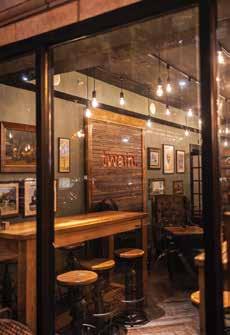
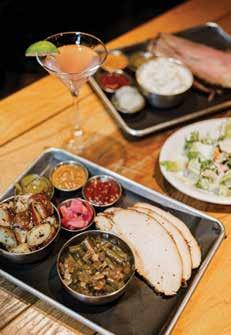
When heading to your room, you’ll notice each suite is thoughtfully designed, o ering unique features. If you’re lucky enough to book the Garden Room, you’ll nd a spacious king bed and access to a private patio — a rare and luxurious perk in the heart of downtown Columbia. It’s a small outdoor space, in the middle of the city, where a guest can enjoy a quiet morning co ee or unwind after a long day. e room’s spacious bathroom and well-chosen amenities ensure comfort.
e culinary journey at e Tiger Hotel begins at Twain: Missouri BBQ & Taproom, a rustic, welcoming space that pays homage to Missouri’s own Mark Twain. e restaurant can be accessed from the street or the hotel lobby. Opened in July 2023, the restaurant is steeped in literary and culinary tradition, with Edison bulbs strung across the restaurant, providing a warm glow over wood cubicles that make for perfect cozy dining spots.
Twain isn’t just a place to eat. It’s a place to connect. e restaurant’s monthly book club, partnered with Skylark Bookshop, creates a space for locals and visitors to gather, sip cocktails, and discuss books inspired by the love of words.
e menu at Twain will make any barbecue lover’s heart sing, o ering smoked meats, tender sides, and classic xings with a unique twist. You might start with slices of smoked turkey, as juicy as they are avorful, paired with a side of green


beans topped with sweet, crispy bacon. e house-made mustard, infused with a punch of horseradish, adds the perfect tang to house-pickled dill and bread-andbutter pickles. Even the sides are memorable — rosemary- avored roasted potatoes so well-seasoned, they could stand alone as a main dish.
As you settle into the meal, you’ll likely exchange banter with Isabella, a laid-back and endearing server who recommends Twain’s signature Huckleberry cocktail, made with huckleberry vodka. And if feeling adventurous, you’ll nd that all the spirits at Twain are sourced from Missouri-based compa-


nies, giving the restaurant’s drink menu an extra touch of local and state pride.
For a nightcap, it’s recommended to head down to e Vault, the Tiger’s hidden cocktail lounge beneath the hotel lobby. is spot is a true gem, where a backlit bar glows in blue, and plush couches invite you to unwind with friends or make new ones. It’s the kind of place that feels both re ned and comfortable, with soft lighting and low co ee tables creating a space that encourages relaxed conversations. Order a Trop Drop, a playful spin on

the piña colada, and you’ll nd yourself savoring every sip of this crowd-favorite cocktail. e Vault is a place for connections, laughter, and lingering. As one guest mentioned to their friend nearby, “I’ve never been here before, but I love the atmosphere.” And it’s hard not to agree.
After an evening of scrumptious barbecue, cocktails, and casual banter, retreating to your room feels like a well-deserved luxury. e comfortable bed is a welcome escape, making it all too easy to sleep in and delay checkout. is style of hotel stay has a certain magic, where every detail makes you feel like a cherished guest.

e next morning, visiting Glenn’s Cafe is the perfect way to wrap up your stay. e cafe’s charming, elegant interior feels like a step back in time, with oral wallpaper, vintage prints, and a piano adding a sense of Southern-inspired luxury. Some readers may recall Glenn’s Café making its rst appearance downtown in the late ‘80s. Waiters in butcher-style aprons bring a unique sophistication to the atmosphere, making brunch here feel like a special occasion.
Glenn’s is famous for its fried chicken and wa es, which truly live up to the hype.
e chicken has a light, crispy layer that locks in all its juicy avor, while the wa es are u y yet not overly sweet, balanced beautifully by the house-made bacon maple syrup. If you’re craving a vegetarian option, the avocado toast with poached eggs is a fan favorite, and the cafe’s signature Bloody Mary or a glass of champagne makes for a perfectly indulgent pairing.
Between Twain, e Vault, and Glenn’s Cafe, e Tiger Hotel has everything you need under one roof, o ering a full range of dining and drinking options that make it easy to relax and immerse yourself in the experience.
“Guests should expect everything they need and more at e Tiger Hotel,” Brooks reminds you, and as you take one last look around the hotel’s sophisticated lobby, there’s a feeling of satisfaction.
e time at e Tiger Hotel is more than just a night at a hotel; it’s a taste of Columbia’s heritage, a celebration of local avors, and an invitation to relax and enjoy yourself if you are a local or from out of town. As you step outside and see the Tiger Hotel marquee one last time, it’s clear that this is not just any hotel. It’s a historic haven, a timeless part of Columbia’s story.





BY HOSS KOETTING

The lights are gone, the decorations are put away, and there is an emptiness of sorts now that January is here. But not to despair — there’s still the college football championship to look forward to while trying to keep the fresh resolutions that were made.
Ah yes. ose pesky resolutions. I suppose you all are trying to avoid ultra-processed foods, re ned sugars, saturated fats, alcohol, red meat, and anything else that makes our existence on this planet enjoyable! Couple this with a gym membership that you can only use before the sun comes up or after you’ve put in your eight to ten hours for the day, and it doesn’t sound too enticing.
But all is not as dire as it sounds. As a wise man once said, “Everything in moderation, including moderation,” so take it easy on the self- agellation. You can still enjoy indulgences while eating better and getting some exercise. You just need to choose wisely.
One tasty option is French Onion Soup. My version of this timeless classic derives its rich avor from the slow caramelization of copious quantities of yellow onions combined with a rich beef broth, some brandy or wine, crispy croutons, and pungent Swiss Gruyère cheese to top it o . One caveat — don’t skimp on the time for caramelizing the onions, as this is what enhances the depth of avor.

Jim “Hoss” Koetting is a retired restaurateur/chef who enjoys gardening, good food, good bourbon, and good friends.

INGREDIENTS Yields 6 bowls or 12 cups
• 3 pounds peeled yellow onions; thinly sliced lengthwise
• 3 tablespoons butter
• 1 tablespoon olive oil
• 1/4 teaspoon sugar
• 3 tablespoons our
• 2 quarts rich beef stock
• 1 cup dry white wine or dry vermouth
• Salt and pepper
• 3 tablespoons cognac (optional)
• ½ lb. grated Swiss Gruyère
• Toasted croutons from French baguettes

1. Sauté onions in a heavy bottomed pot until sweated.
2. Reduce heat, and continue cooking and stirring until they reach a deep amber color.
3. Add sugar, cook for ve minutes. Add our, cook for an additional ve minutes.
4. Add stock, wine, and cognac, then simmer for twenty minutes.
5. Season with salt and pepper. Pour into oven proof bowls, oat croutons, sprinkle generously with Gruyère. Bake until cheese is bubbly.

Whether you’re just getting started or you consider yourself an athlete – get lost in the moment as Engine Room lighting, killer music, energetic coaches and sweaty high fives from the crew create an immersive experience.

For more info, scan the QR code! rhoengineroom.com | 573-889-3145 10 W Nifong Blvd, Ste 115, Columbia, MO 65203

• 21 Days Unlimited attendance
• Crew Success Manager Session with tour
• RHOward for hitting 7 classes within 21 days
• #SHOPRHO swag bag
A very special thank you, Haylee

Haylee is a Marketing Specialist who jumped into her job with a positive attitude despite the mountain of work handed to her. She is well known for her creative approach to social media and her bright, can-do spirit. Everyone knows she is someone you can count on to deliver what she’s promised. The bank is lucky to have such a talented, cheerful person dedicated to her job! 573-874-8100 • centralbank.net/boonebank
BY BARBARA BUFFALOE
As the new year begins, I nd myself re ecting on the privilege of serving as your mayor and the journey that brought me here. In my November column, I shared my belief in authentic leadership — leading in a way that re ects my values and invites everyone to participate. Building on that foundation, my intentions this year center on fostering collaboration, being fully present, and inspiring the next generation of leaders.
Our community thrives when we come together with a shared purpose and respect for each other’s contributions. Meaningful collaboration, as I see it, is essential to creating a Columbia that serves everyone. is isn’t just about partnerships but actively seeking out connections that allow each voice to be heard. True collaboration means making space for all perspectives, especially those that are less commonly heard and that challenge us.

Whether working with city sta , local businesses, non-pro ts, or residents, my goal is to create a space where collaboration drives real progress. A recent example is the Housing Summit we hosted in October, attended by more than 200 people. Builders, neighborhood representatives, non-pro ts, social service agencies, and government o cials gathered to work toward shared goals. I want to build on that success by fostering partnerships that address housing, public safety, climate resilience, and economic opportunity.
In public service, one of the most important qualities we can bring to our work is presence. Today, with full schedules and digital distractions, it’s easy to feel stretched thin. I know I’m not alone in feeling the need for focus, and that’s why I’m committing to being fully present in every space I enter — whether it’s a council meeting, a community event, or a conversation with a resident.
is commitment to presence is closely tied to authentic leadership. To lead authentically, I must be fully engaged with the people and issues around me. When residents share their thoughts, hopes, or frustrations, my goal is to truly listen, fostering a dialogue that allows for openness and understanding. I want to build on our shared trust by being fully here — wherever “here” might be — ensuring that each interaction informs the work we do together.
As your mayor, I’m guided by my belief that one can lead without losing their unique personality or values. I want to bring my whole self to this role. Authentic leadership is not about perfection but about being real. If you’ve met me, you know I speak candidly and am not particularly formal. I’ve found this helps people, especially those new to working in government, feel more comfortable participating. By showing up as myself, I hope to inspire others to see a place for themselves in local government — to understand that they can make a di erence without losing who they are.
It’s my hope that this approach will encourage the next generation to see public
service as a space where they can bring their unique perspectives and personalities. is year, I intend to lead with a commitment to authenticity and inspire future leaders to do the same. Our community’s strength lies in the diversity of voices that shape it, and I hope to see more residents, especially young people, nding their voice. Setting intentions for the new year reminds me of the role each of us plays in creating the Columbia we envision. Whether you’re a long-time resident, a student, a small business owner, or a city employee, I invite you to join me in setting intentions that resonate with our shared values and aspirations. If we each approach this year with a commitment to collaboration, presence, and authenticity, I believe we can create a stronger, more vibrant Columbia that re ects the best of all of us.

Barbara Bu aloe currently is serving her rst term in o ce as the mayor of Columbia.
How to examine the old before moving on with the new.
BY BETH BRAMSTEDT

Ready or not, as you read this column, the calendar has turned. 2024 lays behind us, a urry of memories and past experiences. Our thoughts and feelings have been stu ed deep inside or taken by the wind and sprinkled about, settling in the crevices of our lives like a ne dusting of snow. e forces around us are ready to move forward, to confront a problem head-on, and charge into the new year. ey tempt us to make plans, set resolutions, and ll our calendars. Yet our souls are longing to make sense of what has ended. To metabolize the best of the past year and throw out the rest. Under the steady stream of noise and con icting voices, we long for a sense of closure before moving on. is desire is part of the natural cycle of life.
In the realm of spiritual formation, a practice that ful lls this desire is called the examen
Psalm 139 talks about it like this:
“Search me, God, and know my heart; put me to the test and know my anxious thoughts; and see if there is any hurtful way in me. And lead me in the everlasting way.”
Hundreds of years ago, Ignatius of Loyola created a beautiful way to pray. His method encouraged people to re ect on their day and review how they encountered and
experienced God. is method of prayer is called e Daily Examen. is type of prayer gives time to re ect on the consolations and desolations of the day. e places that brought life and those that squelched or were devoid of life. Following our time of observation, we then ask – where was God in each experience?
An annual examen ful lls the same purpose, only it allows us to trace the movement of God in our life over the course of the year.
I have been reviewing my year for over a decade and wouldn’t miss it! It is one of the most precious, delightful, and helpful ways to spend time with God. It reminds me of where he has brought me from and where he is leading me to.
How do you review your year?
• What were ve places (experiences, relationships, moments in time) when you felt most alive this year?
• What were ve places (experiences, relationships, moments in time) when you felt most distant from God this year?
• What did you read (books, blogs, devotionals, quotes, scripture) that helped you sense God’s presence in new ways, helped you reframe a situation, or led you to better questions?
• What people were in uential in your growth this year?
• Who are the challenges in your life inviting you to become?
• What new questions are you asking yourself? What questions are still lingering?
• What experiences have you been able to share with a listening partner that have allowed you to take the next step of growth or healing?
• What are some new things that you would like to try in the new year?
• Based on what you learned this year, what new relationships would you like to seek out, what boundaries around current relationships need to be established or what relationships need to be let go?
• What are some things you would like to leave behind from this last year?
• How are you learning to live in the present moment in new ways?
• What would you like to pull forward into the new year?
Start with setting aside a few hours. Make your drink of choice, settle in a favorite space, and get comfortable. Open with a few moments and silence and then begin to journal your answers to the questions below from Joan Kelley and Sibyl Towner. Start with the questions that grab your attention, jot down notes, no need to rush. Allow the Spirit to guide you. Disregard the questions that don’t resonate. ere’s no need to answer each one. Beth Bramstedt is the Church Life Pastor at Christian Fellowship.
Blessings as you carry the best of 2024 into the new year!



KRISTA SHOUSE-JONES AND GEOFF JONES BEV & CO. REALTY


REMODELING & ROOFING NATE ANDERSON ROST LANDSCAPING

By Geoff Jones & Krista Shouse-Jones
Find more at bevandcorealty.com

As the new year begins, it’s the perfect time for homeowners to set goals that boost property value and enhance their living space. Whether you’re new to homeownership or a long-time resident, these six resolutions will help you make the most of your home.
1. Declutter and Organize: A clutter-free home creates a peaceful and productive environment. Start by decluttering each room; donating items you no longer need that are in good condition, and discarding those beyond repair. Use storage solutions like shelves, bins, and organizers to maintain order. An organized space not only looks better but enhances your quality of life.
2. Prioritize Home Maintenance: Regular home maintenance is key to preserving your property’s value. Create a schedule for tasks like cleaning gutters, inspecting the roof, servicing HVAC systems, and checking for water damage or pests. Addressing issues early saves time, money, and stress. Hire professionals for specialized tasks to keep your home in top shape year-round. Need Columbia, MO contractor recommendations? Ask for our trusted vendor list!
3. Create an Outdoor Oasis: Treat your outdoor space as an extension of your
home. Create a relaxing oasis with comfortable seating, lush plants, and ambient lighting. Whether it’s a large backyard or a small patio, add personal touches that reflect your style and enhance the space’s beauty.
4. Invest in Sustainable Upgrades: Now is the perfect time to make your home ecofriendly. Invest in sustainable upgrades like solar panels, energy-efficient appliances, and smart home technology to cut your carbon footprint and save on utility bills. Consider incorporating materials like bamboo flooring or reclaimed wood furniture for a stylish look while promoting responsible consumption.
Prior to their career in real estate, Geoff and Krista served our community as Columbia police officers for over two decades. Their extensive knowledge of Columbia’s dynamics and inner workings is instrumental in serving their clients. They take great care to help our neighbors and future neighbors succeed in their real estate goals and invest in their futures, whether that’s buying a first home, transitioning to a new one, or venturing into rental properties.

489-4961 Krista@bevandcorealty.com

5. Embrace Energy Efficiency: In addition to investing in sustainable upgrades, focus on including energy-efficient practices in your daily life. Simple changes such as turning off lights when not in use, using programmable thermostats, and minimizing water waste can make a significant difference in your home’s energy consumption. Educate yourself on best practices to reduce your environmental impact and lower your utility bills.
6. Support Local Businesses: As a homeowner, you have the power to support local Columbia, MO businesses and contribute to our community’s economic vitality. Resolve to shop locally whenever possible, whether you’re purchasing home decor or hiring contractors for renovations. Not only will you foster a sense of community pride, but you’ll often find unique and high-quality products and services that you won’t find at big-box retailers.
The new year offers a fresh start and an opportunity to elevate your lifestyle as a homeowner. By making these six resolutions, you’ll create a more sustainable, organized, and harmonious living environment that improves your quality of life.

By Austin Hall
When we think about health and wellness, we often focus on the things closest to us—our physical fitness, mental well-being, and diet. But what about the health of the very structure we live in? In fact, your home’s exterior is your family’s first line of defense against the elements. At Heartland Homes, we believe that maintaining the health of your home’s exterior directly impacts the wellness of everyone inside.
A solid roof does more than keep your house dry. It protects your family from mold, mildew, and the health risks associated with water damage. In the Midwest, hail and high winds can wreak havoc on roofs, causing shingles to loosen or fall off entirely. This can lead to leaks and, over time, compromise the structural integrity of your home.
Heartland Homes offers free, noobligation inspections and estimates to ensure your roof remains watertight and secure. Plus, we work directly with your home insurer to see if repairs or replacements are covered, saving you stress and money.
If the roof is your home’s primary protector, siding is its loyal second-incommand. Siding shields your house from the elements, insulating it against extreme temperatures and keeping pests at bay. Damaged siding—whether vinyl, composite, or wood—can lead to drafts, water infiltration, and even pest infestations. These issues can affect your home’s energy
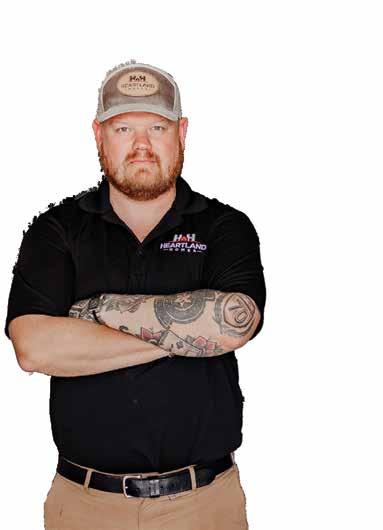
Austin Hall is co-owner, salesman and designer at Heartland. Before starting Heartland, Austin spent eight years perfecting his skills in custom cabinetry and countertop design and installation. Austin has been a board member of Columbia’s Home Builder Association since 2020, he is currently serving as the President and has been either co-chair or chair of the MidMissouri Home Show since 2018. He, his wife Khila and two children, Rylan and Beckett, live in Rocheport and love to relax at the Lake and travel.


efficiency, as well as your family’s comfort and health. Keeping your siding in top shape ensures your home remains a safe and comfortable haven.
Wellness isn’t confined to the indoors, either. A well-designed deck or patio can become a sanctuary for relaxation, connection, and fresh air, where you can enjoy your morning coffee in peace or host a gathering with loved ones; outdoor spaces enhance your quality of life.
Let our team transform your outdoor area into a functional and beautiful extension of your home, creating a perfect balance between form and function.

At Heartland Homes, we understand that a healthy home contributes to a healthy life. Whether it’s a watertight roof, durable siding, energy-efficient windows, or an inviting outdoor space, we’re here to ensure your home’s exterior supports your family’s well-being. With free inspections, highquality materials, and insurance expertise, we’re committed to protecting your biggest investment—your home—and the health of those who live in it.
Contact us today to schedule an inspection and take the first step toward a healthier home and lifestyle.
By Nate Anderson
Find more at rostlandscaping.com
Landscape edging is a crucial component of outdoor design, offering functional and aesthetic benefits. It defines garden beds, walkways, and lawns, providing a polished look while keeping materials contained. To achieve professional results, it’s important to follow some key dos and don’ts.
• Plan Ahead: Before you begin, take the time to map out your project. Determine where you want your edges, the materials you’ll use, and the overall design. Sketching a plan helps avoid mistakes and ensures a cohesive look.
• Choose the Right Material: Selecting the appropriate edging material is vital. Options include plastic, metal, stone, and brick. Each has its pros and cons, so consider factors like durability, style, and budget. Another option is opting for a hand-spaded edge. This is done by cutting a V shaped trench to act as your gradient between mulch and turf. A hand-spaded edge is not typically recommended with gravel beds.
• Define the Purpose: Understand the functional role of your edging. Do you want to keep mulch from spilling into the grass? Prevent grass from invading flower beds? Your goals will influence the type and installation of the edging. It is important to note that edging is not for weed control, and that it is mostly an aesthetic choice.
• Excavate Properly: Digging a trench for your edging is essential for stability and longevity. Use a spade or an edging tool to create a clean, level trench. The depth
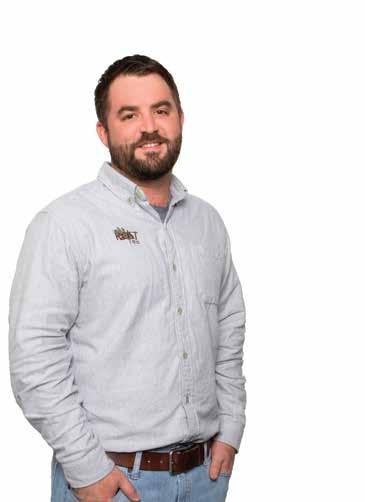
will depend on the material, but most projects require at least a 2–3 inch trench to secure the edging.
• Incorporate Safety: Ensure all materials are secured properly. Sharp edges or unstable stones can pose hazards. Metal options do have the tendency to have sharp edges so it is important to take caution.
• Don’t Skip Preparation: Jumping straight into installation without preparing the area is a common mistake. Failing to clear debris or grade the soil can lead to uneven and unsightly results.
• Don’t Choose Cheap Materials: While budget-friendly options may be tempting, low-quality materials often deteriorate quickly, requiring replacement. Invest in durable, weather-resistant materials to save money and effort in the long run.
• Don’t Overcomplicate Designs: Simple designs often yield the most visually appealing and practical results. Overly intricate patterns can be difficult to install and maintain. I also recommend against using too many materials types. Stick to one or two complementary materials for a cohesive look.
Nate Anderson has been a resident of Columbia for seven years, and he has been working in the landscape industry for just as long. Nate is a designer and estimator for Rost Inc. While working on his degree in plant science and landscape design, he also worked as a foreman at Rost Landscaping, where he oversaw landscape construction projects. He credits much of his inspiration to his “early years” where he got to be a part of the construction of many beautiful landscapes.

• Don’t Neglect Maintenance: Even the best edging requires upkeep. Over time, soil and mulch will shift affecting the appearance and functionality of your edging. Regularly inspect and adjust as needed to maintain its integrity. In Missouri everything moves with freeze and thaw.
• Don’t Forget Drainage: Improperly installed edging can impede water flow, causing pooling or flooding in certain areas. Ensure your design allows for proper drainage to avoid damage to your landscape.
By following these dos and don’ts, you can create a well-defined and visually appealing edge that enhances your outdoor spaces. With proper planning, quality materials, and regular maintenance, you can ensure your edging will stand the test of time. Hiring a qualified designer is a great way to get guidance on your edging selection as well as your overall design.










Sabrina Basinger Financial Advisor

Barred Owl serves up fl avorful fi zz — without the buzz.
PHOTOS
BY
KEITH BORGMEYER


1.5oz


For the sober curious, there are myriad ways to cut back, define the journey, and even raise a glass.
BY CAROLINE DOHACK
Could this be the year of the soda water?
While the majority of Americans do enjoy a tipple, a growing number are deciding to give temperance a try. Researchers have dubbed this mass curtailing “the sober-curious movement.”
As with so many social phenomena, the youth are leading the charge. A 2020 study published by the Journal of the American Medical Association found that 28 percent of college students surveyed in 2018 said they didn’t drink alcohol, up from 20 percent in 2002. In a literature review published in e Conversation, researchers from Wilfrid Laurier University in Ontario, Canada, explore the reasons Generation Z isn’t as interested in imbibing. What they found is that Zoomers tend to be more informed on health topics and committed to prioritizing mental health.
Heather Harlan, a health program coordinator at the Columbia/Boone County Department of Public Health and Human Services, says media literacy might also be contributing to the sober curious trend.
“Young people are becoming more savvy,” Harlan says. “ ey understand how the alcohol industry has targeted them, and they’re getting tired of it.”
e movement also brings with it an element of inclusion. After all, there’s no one reason a person might choose sobriety.
“ ey may be in recovery,” Harlan says. “It may be for health reasons. ere are a lot of medications you shouldn’t take if you’re using alcohol. You may be a caregiver or a parent or there’s someone else you’re responsible for, and drinking would compromise that. ere are a lot of reasons you may say, ‘No, thank you.’”
When more people are open to sobriety, it means there’s a seat at the table — whether that table is at a social gathering, in a restaurant, or even at happy hour — for everybody.
“ ey’re able to have social gatherings where everyone is welcome, everyone is comfortable and safe,” Harlan says. “It’s becoming more important to all of us.”
It wasn’t that long ago we extolled the virtues of red wine as a heart-health elixir when enjoyed in moderation. e guidance at the time established “moderation” to mean no more than 14 servings of alcohol — a serving meaning 12 ounces of beer, 5 ounces of wine, or 1.5 ounces of liquor — over the course of a week, with no more than four servings in one sitting. For women, it was seven servings a week with no more than three in one sitting.
“ ere’s de nitely been a big shift in the way we think about alcohol use,” says Dr. Lucas Bu aloe, a family medicine physician at University of Missouri Health Care. ese days, doctors are telling their patients that the healthiest amount of alcohol is no alcohol. Bu aloe says even moderate consumption is linked to various types of cancer, heart and liver diseases, mental health issues, and dementia later in life. And according to the Centers for Disease
Control and Prevention, more people are dying from alcohol-related causes such as alcohol poisoning and conditions attributable to excessive alcohol consumption over time. From 2020 to 2021 there were 178,000 such deaths, up 29 percent from 2016 to 2017. If you break it down, that’s about twenty deaths every hour.
So what happened to red wine as a part of a heart-healthy lifestyle?
“ e perceived health bene ts came from some studies that are now felt to be outdated,” Bu aloe says. “It turns out it wasn’t so much the alcohol use that was healthy, it was some of the other healthy habits that people who drank in moderation have.”
But here’s the thing: Alcohol plays with our brains in a way that can make moderation di cult. As a central nervous system depressant, alcohol inhibits brain activity and slows everything down. Bu aloe says that’s why some people experience a sedative e ect. But alcohol also triggers the release of the body’s natural opioids, which gives the sensation of pleasure.
“One of the tricky things about that is because we experience pleasure when we drink alcohol, it can lead us to think more alcohol will produce even more pleasure,” Bu aloe says. “ at may lead people to have two or three drinks when maybe one would su ce.”
But more people are catching on that heavier drinking isn’t actually doing them any favors. Bu aloe says he’s noticed an uptick in the number of patients who want to cut back.
“People are interested in changing habits as the new year begins, but part is a replication of this overall trend toward reducing drinking,” Bu aloe says.
Stereotypes about alcoholism can make it easy to overlook signs there might be trouble. For Cassi Cody, 52, the image of someone else — it would never be her — holed up alone and binge drinking offered some plausible deniability.
“I drank socially, and there’s less stigma associated with social drinking,” says Cody, a business development representative. “I would just call myself a social drinker. Well, if you socially drink until you’re blackout drunk, that’s a problem.”
e problem with social drinking, though, is that Cody is a social person.
“So much in Columbia is based around going out to eat or having a cheap Chardonnay at a mixer or stu like that,” Cody says. “It was so easy to go to a little networking thing and have some Chardonnay and then go somewhere else and have a little more.”
But once the good times — or at least they felt like good times — got rolling, Cody had a hard time slowing down.
en, on the Saturday before anksgiving 2022, Cody came home from a night out, slipped in the bathroom, and hit her head on the sink faucet — resulting in a big gash.
“I had to wake up my husband. Or maybe he woke up. I don’t know because I was so drunk I don’t really remember,” Cody recalls. “Of course, with all that comes terrible shame. Every time I drank, I had shame and post-alcohol depression. is time it was compounded. ere was the shame of being blackout drunk, and the shame of scaring my husband and son, who was 18 at the time.”
Cody spent the next several days in bed, too ashamed to even look at herself in the mirror. When she nally emerged on anksgiving day, she was resolved: She was done drinking.
Her husband and son were supportive. So, too, were her close family and friends. “ ey completely supported me. is wasn’t just a ‘me’ issue, it was something that a ected all of us,” Cody says. “More than anything they loved me, and they didn’t blame me for what happened. ey didn’t blame me for the fall, they didn’t make me feel bad. ey knew I felt bad. ey knew I was punishing myself enough. ey love me, and I needed to
give that love back to them. I needed to show them that I loved them enough to get sober. Getting sober was important for me, but they were my reason.”
But while she was able to nd comfort and support from her nearest and dearest, walking away from alcohol meant walking away from some places and people.
“One was a group of friends,” Cody says. “ eir lifestyle really revolved around drinking, and I couldn’t be around that.”
But the longer she worked on her sobriety, the easier it became — not just the stick-to-itiveness but the ability to sit with thoughts and live every moment fully.
“Since I’ve become sober, I’ve just become an emotionally stronger person,” Cody says. “ ings before that I used alcohol to cope with, well, now I have to process those feelings. I have to work through it, I have to experience it. It gives me strength, and I just keep getting stronger.”
Today she’s not triggered by other people drinking. If you were to join her for dinner and order a beer or a glass of wine, it won’t bother her. But what she’s found is that there’s a lot to love about being a homebody.
“I’d rather order Jina Yoo’s and bring it home and sit in my PJs and eat sushi than anything else,” Cody concedes. “We have what we call a lounge out in our garage, and we sit out there with the garage door open because it looks out at all these trees, and I drink my kava hot tea. I talk to my guys, or sometimes we watch something on the TV or sometimes we sit together and ignore one another and play on our phones. at’s my life now, and I love it.”
A quick but important caveat on quitting cold turkey: Bu aloe says it’s safe for most people to stop drinking, but people who drink more than one or two drinks every day might be at risk for alcohol withdrawal. For these folks, withdrawal can set in within a matter of hours. Symptoms can include anxiety, rapid heart rate, sweating, nausea, and tremors. In severe cases it can cause delirium and seizures, making it a potentially life-threatening

“ ey knew I felt bad. ey knew I was punishing myself enough. ey love me, and I needed to give that love back to them. I needed to show them that I loved them enough to get sober.
Getting sober was important for me, but they were my reason.”
— CASSI CODY

“ ink about the e ect alcohol has on you — good or bad. Most of us will use it to relax or enjoy a social situation, but we might also experience fatigue or maybe feel less connected or engaged when we drink alcohol. My goal with those discussions is for people to rethink their behavior and drink in a way that’s healthier for them.”
— DR. LUCAS BUFFALOE
medical problem. Bu aloe says there are treatments that can prevent a person from experiencing these symptoms, and he encourages those with a history of heavy drinking to consult their primary care providers about the best way forward.
When Bu aloe speaks with patients who are interested in quitting, he asks them to consider a few things.
“First, consider why you’re drinking,” Bu aloe says. “Are there alternatives to alcohol that would be just as satisfying to you? Second, consider how much you need to drink to achieve your desired result. Maybe one drink is good enough.
ink about the e ect alcohol has on you — good or bad. Most of us will use it to relax or enjoy a social situation, but we might also experience fatigue or maybe feel less connected or engaged when we drink alcohol. My goal with those discussions is for people to rethink their behavior and drink in a way that’s healthier for them.”
Bu aloe notes that for some, medications like naltrexone and acamprosate can help with cravings. And for many, support groups are a fantastic source of encouragement and accountability.
Twelve-step programs like Alcoholics Anonymous use peer support to help people work through their challenges. A substantial strength of AA is its ubiquity, which helps with access issues.
“Columbia has a very robust network of AA meetings,” Bu aloe says. “ ey’re available every day of the week, multiple times a day.”
But AA isn’t the right t for everybody. Harlan points out that it’s sometimes hard to live up to the all-or-nothing emphasis on counting consecutive days.
“I’ve known people in AA who would lie about whether they used because they would lose their status if they couldn’t say, ‘I’ve had 142 days sober.’” Harlan says. “If they say, ‘I drank last week,’ they have to start over.”
And, Harlan says, people who are doing the work of cutting back deserve some grace.
“People don’t get high blood sugar or high blood pressure under control on their rst try,” Harlan says.
Other programs o er a contemplative approach. Annie Grace’s is Naked Mind program uses psychology — notably cognitive behavioral therapy, or CBT, a modality that helps people challenge harmful patterns through positive thought processes — and neuroscience research to teach people new ways to think about cravings and triggers. Grace’s book e irty Day Experiment calls on readers to abstain from alcohol for 30 days, during which they get a dayby-day breakdown on what’s happening to their body as it recovers.
(A quick note about month-long challenges like Dry January and Sober October, during which participants avoid alcohol for the duration of a calendar month. Bu aloe likens them to crash dieting.
“You’ll see bene ts while sticking to it, but most people go back to the behaviors they were participating in before they started it. Alcohol use is like any other behavior. You want to think about how you’re going to do this long-term,” Bu aloe says.)
Another popular book in sobriety circles is Quit Like a Woman, a feminist perspective on sobriety written by Holly Whitaker, who also founded a moderated online support group for women and nonbinary people called Tempest. Tempest later merged with Monument, an addiction-treatment telehealth company that o ers virtual counseling, prescriptions for medications to help with cravings, and moderated online support groups.
Locally, a number of private practice therapists o er addiction counseling. Bu aloe lists Phoenix Programs, Burrell Behavioral Health, and Compass Health as additional options.
And if you don’t necessarily need that much intervention, there’s no shortage of sobriety apps. Cody likes the Nomo Sobriety Clock, which tracks days of sobriety as well as stats like money saved, calories burned, and time not wasted. ere also are community features that allow users to nd accountability partners and check in with one another. While Cody has never been an especially active chatter in the app, she does enjoy sharing her wins.
“It has felt good to go in there and say, ‘I’m at this point in my sobriety.’ Life is so much better, it’s so much clearer. Wonderful things happen on the sober side,” Cody says.
We used to understand the term “sober” as meaning completely abstaining from intoxicating substances. But these days, there’s more than one way to be sober.
“People whose use of alcohol and other drugs has caused problems can use sober curious as a way to actively take stock,” Harlan says. “It’s an opportunity to understand an impulsive moment and how using again might result in a return to the problems that had occurred before when sobriety was not on their radar. Ultimately, people will choose their own lifestyle; the rest of us can more actively work to support and not undermine healthier choices.”
Sober curious refers to a period in time in which a person explores moderation or abstains entirely. It can be temporary or permanent. Harlan says sober-curious periods are the perfect opportunity to focus on re ection.
“Pay attention to ‘How do I feel?’ ‘How much more money do I have in my pocket?’ ‘How nice it is to wake up after an evening with friends and I don’t feel awful,’” Harlan says. “I like to feel good. What helps you feel good?”
Intermittent sobriety is a term used to describe scheduled moderation. As with intermittent fasting, a person practicing intermittent sobriety schedules when and how much they will drink. (As someone who is intermittently serious about her running, I nd this model helps me stay strong without succumbing to allwork-no-play pressures.)
“I think of it the same way we might think about other things we might enjoy, like sugar. Who doesn’t like sugar?” Harlan says. “But we know it needs to be an occasional treat, not a rich dessert every night.”
And then there’s California sober. is controversial approach to sobriety entails forgoing alcohol and/or hard drugs in favor of cannabis. ere’s a mind-altering substance in play, which means some activities — think: driving — are danger-
ous. However, some nd this approach makes it easier to avoid alcohol.
Just because someone isn’t drinking alcohol doesn’t mean they’re not drinking something delicious. According to the IWSR, a global drinks data and insight provider that used to be known as the International Wine and Spirits Record but has since changed its name to IWSR to indicate expertise in beer and — wouldn’t you know it? — no- and low-alcohol beverages, U.S. sales volumes for nonalcoholic beverages were up 29 percent in 2023 compared with 2022’s numbers.
ere’s Seedlip, a botanical-based non-alcoholic spirits brand from the UK. You can nd it locally at Schnucks or Macadoodles. Las Margaritas has an entire menu of nonalcoholic cocktails using Seedlip.
ere also are a number of brands like Ritual, Cut Above, and Free Spirits, which make non-alcoholic versions of gin, tequila, whiskey, rum, and other bar cart staples. You can try them at restaurants like Lee Street Deli, Flat Branch Pub & Brewing, CC’s City Broiler, and Broadway Brewery, or pick up a bottle or two for yourself at Gerbes, Schnucks, or Hy-Vee.
Sycamore and Barred Owl Butcher & Table both make their own shrubs inhouse. Also known as drinking vinegar, shrubs are made with fruit, vinegar, and sugar in a 1:1:1 ratio. Mixed with seltzer or soda and your favorite fruit juices, they hit the perfect balance of sweet and acidic.
Non-alcoholic beers also have gotten a glow-up since O’Doul’s launched in 1990. Stalwarts like Sam Adams, Budweiser, and Heineken all o er zero-proof versions of the brews that made them famous.
Columbia’s own Logboat Brewing Company has been exploring non-alcoholic options as well. In an Instagram post last September, it introduced its Logboat Hop Water — soda water avored with hops. Logboat indicated that its hop water would be the rst in a series of non-alcoholic explorations.
And in the meantime, soda water is delicious.

“ ey may be in recovery. It may be for health reasons. ere are a lot of medications you shouldn’t take if you’re using alcohol. You may be a caregiver or a parent or there’s someone else you’re responsible for, and drinking would compromise that. ere are a lot of reasons you may say, ‘No, thank you.’”
— HEATHER HARLAN
BY RYAN SHEEHAN
Columbia has a vibrant comedy scene – a laugh factory, if you will – for local comedians. One place where laughter routinely escapes is Eastside Tavern on Tuesday nights, as part of e As Yet Unnamed Comedy Show. e show is an open mic, meaning it is free for any comic who wants to sign up.
Several locals have hosted the show over the years, including recent and current hosts Prim Stonebraker, Jacy Tate, Nick Gorges, and Xavier Arnold.

Primula “Prim” Stonebraker is a senior MU student majoring in digital storytelling and she works at the escape room Breakout CoMo. She has been performing stand-up at Eastside Tavern since June 2024 but has been doing stand-up in general since she was a freshman at MU in October 2021. Stonebraker said that stand-up was the rst type of comedy that she became involved in, adding sketch and improv quickly afterward.
However, her interest in writing stand-up goes back further than her college experience.
“I started writing stand-up when I was 11,” Stonebraker said. “Just because I was super obsessed with Jimmy Fallon. And I wanted to be the next Jimmy Fallon, or whatever. But I gave up after three months because I didn’t know how to do it. But I was always interested in comedy and SNL. So, I just came back to it when I joined college.”
Stonebraker said that she does comedy every day, whether it’s performing or rehearsing.
“ ere is never a single day with a break (from comedy) at this moment,” she said.
Along with stand-up, Stonebraker said that she has been involved with travel teams for improv, performing across the country and in front of hundreds of people. When Stonebraker graduates from MU, she plans on moving to Chicago with her friends and doing improv classes. If it goes well, she said that there will hopefully be scouts from Saturday Night Live and Comedy Central. ere will also be larger venues for stand-up in Chicago.
Stonebraker said that she hopes comedy is something that will stick and she will eventually be paid to do it. But even if she had to do it for free, she said that comedy is her life’s goal.
“I think you should be putting in two times more e ort in the stand-up you’re creating by yourself, than the stage time you’re getting to perform in front of other people,” Stonebraker said. “I think people say perform the most you can, but I say write the most that you can. And then start worrying about your voice and stage presence, after you have an archive of bits that would work no matter who says them.”

Another host of e Yet To Be Named Comedy Show is Jacy Tate. She has been giving comedy a try for about eighteen months and has had hosting duties since July. Tate
said that she enjoys hearing the comedians each week, hearing their new material, and seeing them progress. For people who have never performed before, she recommended writing their material down.
“Even if you are funny situationally, that does not mean that you can just get up there and just talk and people are gonna laugh,” she said. “Eastside is kind of unforgiving in that manner, as most open mics are. But it’s a lot of fun. Once you get up there, once you try it, and you are going to bomb at least once in your career, even the professionals bomb, don’t avoid getting up there because of bombing. It’s part of it. I’ve bombed and I’m the funniest person that I know.”

Another co-host and stand-up comedian in Columbia is Xavier Arnold. He has been doing stand-up for almost three years. Arnold said that his plans for his comedy include creating “ e Yet To Be Named Comedy” podcast to interview local comics.
Arnold said his style of comedy is silly, explaining that he is too young to have a “real perspective on the world.” He also said that learning to perform stand-up is challenging, but aspiring comics have to do open mics.
Scan the QR code to meet the rest of our local COMO comedians online.
We’ve all heard that “a spoonful of sugar helps the medicine go down,” and that might be true, but it’s also a home remedy that can create other health problems. Too many spoonsful of sugar can also wreak havoc with blood chemistry and metabolism, while also triggering taste buds to seek out even more carbs.
But don’t let that bit of medical caution get in the way of a good snack attack. Whether it’s a spoonful of sugar or a can’t-miss herbal concoction, here are some home remedies that our Facebook and Nextdoor friends are passing along.
Editor’s note: ese remedies may or may not have been tested by the Food and Drug Administration, they may or may not be recommended by your physician, and they may or may not work. In other words, if you use any of these and have adverse outcomes, please don’t sue us.

Passion ower tincture for anxiety. You can buy it at health food stores, or you can make your own by lling a jar with dried ower heads, pouring some vodka over the owers, smacking a lid on that bad boy and letting it sit for a month or so. e plants are really pretty, and you can grow them in Missouri. Strain it into a dropper bottle. en when you get the anxiety scaries, you drop 2-3 drops under your tongue and hold it down for about a minute.
– CAROLINE DOHACK
My mother SWEARS by putting Vicks on the bottoms of your feet when you’re sick.
– MADELEINE LEROUX
For a sore throat, boil hot water, lemon juice, and honey. Don’t let the honey melt. It will coat the back of the throat, and thus the sore throat will be gone after a few cups.
– THERESA McBRIDE CUPP
Whiskey. Takes away the blues and pain.
– LYLE GARRETT
Ginger ale for an upset stomach.
– SUE JESSE
Plain rice cooked in homemade chicken broth for upset tummy.
– KATIE K.
My family used to use gasoline siphoned from the tank as an antiseptic for wounds. Can’t recommend it.
– MELISSA OFFICINALIS
Onion syrup ... Cures what ails ya. LOL.
– SUSAN BORCHERDING
Swallowing a spoonful of sugar cures hiccups.
– VANESSA HALL
Sliced onions on a plate in the room (especially while sleeping) as a decongestant. It seemed to work. It’s not real strong but is constant. I actually got this tip from someone not in my family, but a household of two doctors, of whom one said his mother and grandmother did it!
– BETTE NORMAN
Homemade elderberry syrup daily throughout the fall and winter has really helped me stay well even when my husband is sick. I also take Vitamin C, zinc, and garlic when exposed to people who are sick. I haven’t had the u in at least ten years.
– TARA ADINOLFI

MU Health Care’s new Birthing Center is a place built for the best beginnings. Where moms-to-be have everything they need — like low intervention birthing rooms and state-of-the-art C-section suites, a calming atmosphere with larger, completely private rooms and dedicated experts for mom and baby in one location. It’s a place for bonds to build and families to grow, and it’s now open.